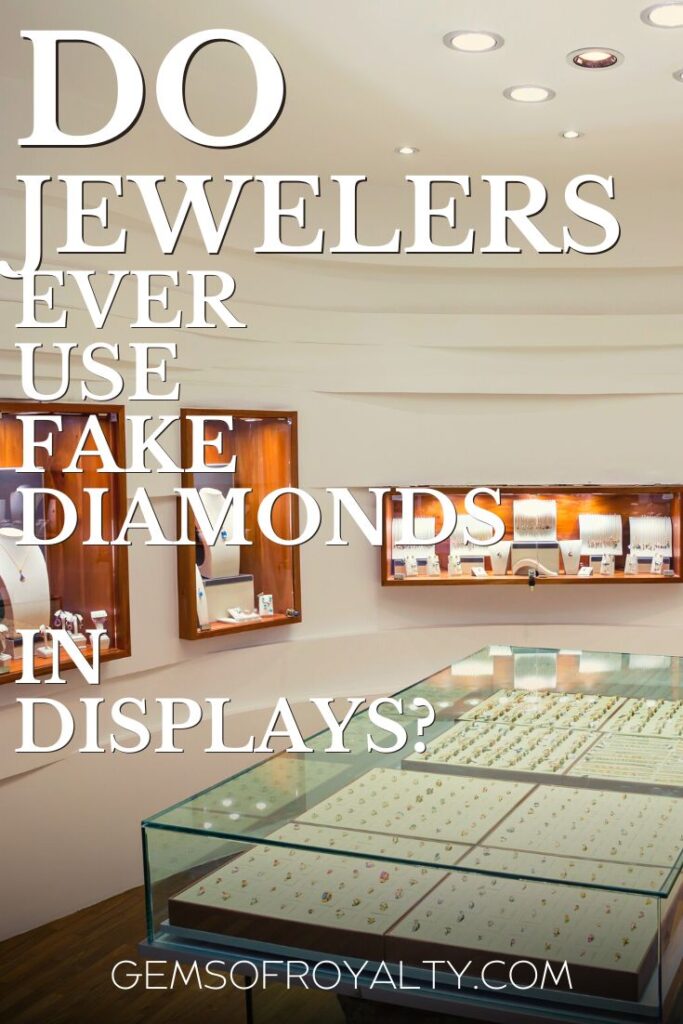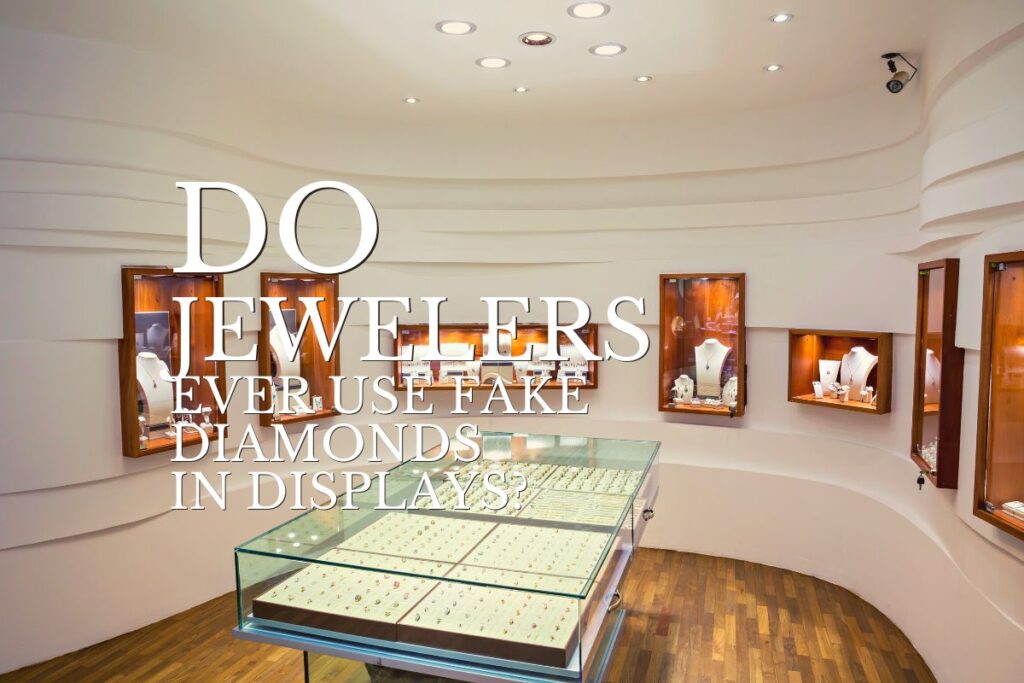Jewelry stores are the epitome of luxury, complete with an inviting atmosphere and a vast assortment of glistening diamonds displayed under bright lights. At times the sheer amount of diamonds can be overwhelming, and if you’re anything like me, you’ve often wondered: Are all of these diamonds real, or do jewelers use fakes?
Some jewelers use fake diamonds in their display cases. This is done primarily for concerns about theft. Also, at times it’s more cost-effective to order certain pieces upon request instead of having them displayed and stocked.
Through the rest of this article, I’ll provide more information on why jewelers use fake diamonds for display purposes, what exactly fake diamonds are made of, and a few tips on how to differentiate real diamonds from fake ones.
Why Fake Diamonds Are an Efficient Choice for Jewelers
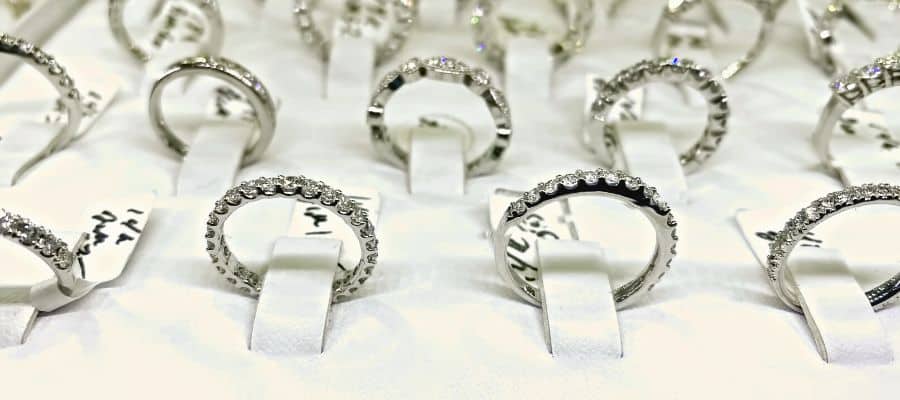
Jewelry consumers often visit physical stores to try on the actual piece of jewelry they are interested in purchasing. In most cases, this is still possible, even though the diamond in the display case might not always be real.
Using fake diamonds for display purposes often proves to be an efficient choice for jewelers as it can both minimize risk and help offset inventory costs. Some jewelry is so rarely sold that only a fake display is kept in-store, while the actual piece must be ordered for viewing or purchase.
In other instances, while the diamond in the display may be fake, the jeweler can re-set it with the actual diamond, which is kept in a more secure location but still on the premises.
Although the practice of presenting fake diamonds is often a safe choice for jewelers, it doesn’t come without some drawbacks, some of which can affect consumers. When jewelers present jewelry that isn’t real, many consumers find themselves questioning whether the piece they are purchasing will be real.
Additionally, some jewelry stores use a mixture of real and fake diamonds in their display cases. This practice has led to increased concerns regarding customers accidentally being given jewelry with fake diamonds. This is less of a concern with experienced jewelers, as they can readily tell the difference.
However, a mix-up like this could be much more likely at jewelry stores where personnel may not be as experienced.
What Are Fake Diamonds Made Of?
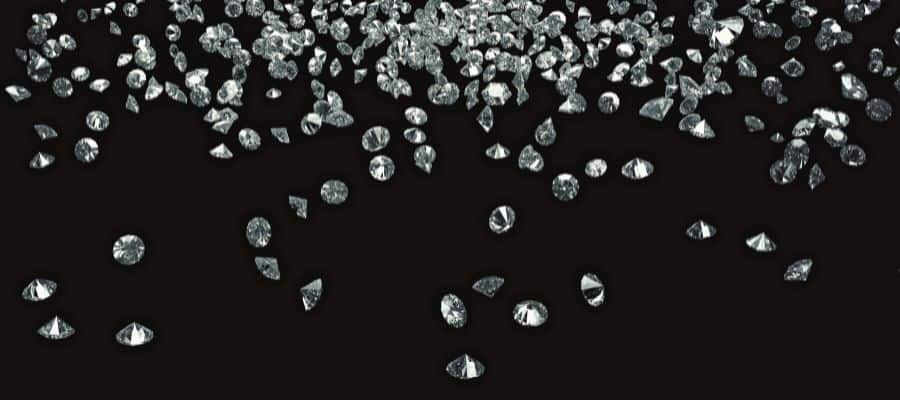
Today, some fake diamonds are so advanced that often even the most experienced diamond connoisseurs struggle to tell the difference. With the look and feel of fake diamonds closely resembling the real ones, what exactly are these simulants made of?
Cubic Zirconia
The vast majority of fake diamonds you’ll find on the market today are made of cubic zirconia. It is the most popular diamond dupe due to its close resemblance to the real thing, hardness, and low cost.
Zirconium oxide is the chemical combination behind cubic zirconia and was first discovered in 1982. However, zirconium oxide in its natural form looks nothing like the sparkling diamond look-alikes we see in stores.
For the white, powdery substance to be transformed into sparkling cubic zirconia it must be heated to an extremely high temperature and stabilized with the help of ingredients such as magnesium and calcium. Essentially, the stability and durability that cubic zirconia is known for are only present at high temperatures. In its natural state, zirconium oxide is so delicate it could easily be taken by the wind.
Although cubic zirconia is the most common fake diamond, contrary to popular belief, not all fake diamonds are cubic zirconia. Diamond simulants can be composed of many different elements, another one of note being moissanite.
Moissanite
Moissanite is made of silicone carbide and, similarly to diamonds, can either be found naturally or be lab-created. It was named after Henri Moissan, the french scientist who first discovered the mineral in 1983.
When Moissan first discovered the mineral in Arizona he originally mistook it to be a diamond; it was only upon further examination that he discovered it to be a rare natural occurrence of moissanite. The fact that a chemist initially couldn’t differentiate moissanite from a true diamond is quite a testament to just how good of a fake moissanite can be.
Similar to cubic zirconia, moissanite is created primarily in the lab through the use of pressure and heat. Although there have been instances of moissanite found in its natural form, it continues to be extremely rare.
Ways To Spot a Fake Diamond
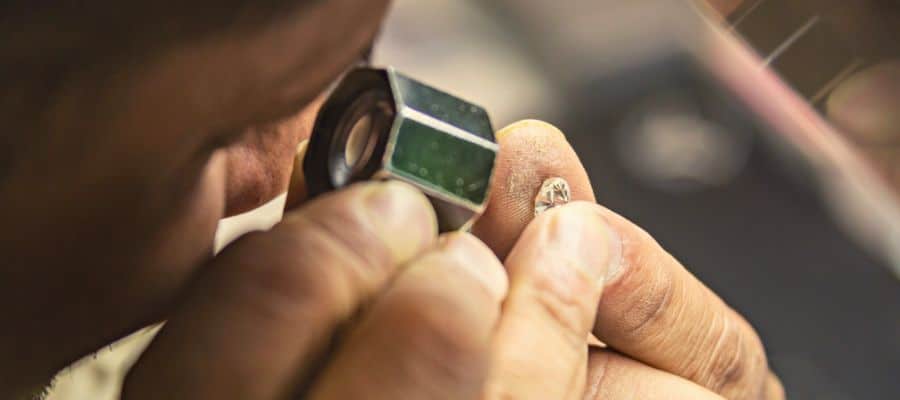
With imitation diamonds being so similar to real diamonds, many people find themselves asking the age-old question: How can I spot a fake?
For starters, it’s always a good idea to simply ask your jeweler. Most jewelers are honest about the contents of their jewelry, as misleading customers could lead to a bad reputation and decreased business.
However, if you still harbor concerns, implement the simple tests below to figure out whether you’re in the presence of a true diamond or a dupe.
Water Glass Test
If you have a loose diamond, you can conduct a water test. Fill a clear glass to almost full with water and drop in the suspected diamond. If it sinks to the bottom, it is a real diamond, as true diamonds are denser than water. If it floats to the top or just beneath the surface of the water, it’s a fake.
Check the Setting
Another easy way to gain information about a diamond is to check its setting and mount for engravings. It’s unlikely that a real diamond will be set in a cheaper metal such as stainless steel, so you’re looking for the engravings of pricey metals. For example, 18K, 10K, PT, etc.
Fog Test
The fog test is ideal for diamonds in a setting. Simply breathe on the ring and take notice of the fog your breath leaves behind. If it’s a real diamond, the fog should dissipate almost immediately. However, if it’s fake, the fog will linger and take several seconds to clear.
Reflection Test
You can also check the diamond’s reflection. Either shine a small light through the diamond or hold it up to the light. When looking through a true diamond, you should see reflections in shades of gray, while many fakes will reflect a rainbow.
Use a Loupe
Lastly, you can use a loupe to inspect the diamond. A loupe is a magnifying glass for jewelry most jewelers have. The science behind a loupe and how it enhances our view makes it a great tool for viewing a diamond’s details.
Look for imperfections (inclusions), which most true diamonds have and most fake ones won’t. However, be wary of basing a diamond’s validity on this test alone, as some true diamonds can appear perfect.
Conclusion
Some jewelers have been known to use fake diamonds in displays, although this will largely depend on the jeweler.
Many jewelers have found that presenting fake diamonds on display helps minimize their risk when it comes to possible theft and saves on inventory costs. Others are strongly against it, citing concerns regarding consumer trust and possible confusion between real and fake pieces.
Many consumers find themselves wanting to be sure they are receiving a real diamond. Luckily, there are quite a few ways to differentiate a real from a fake, including the fog, water, and reflection tests.
If you found this article useful, make sure you save this pin below to your Jewelry board.
